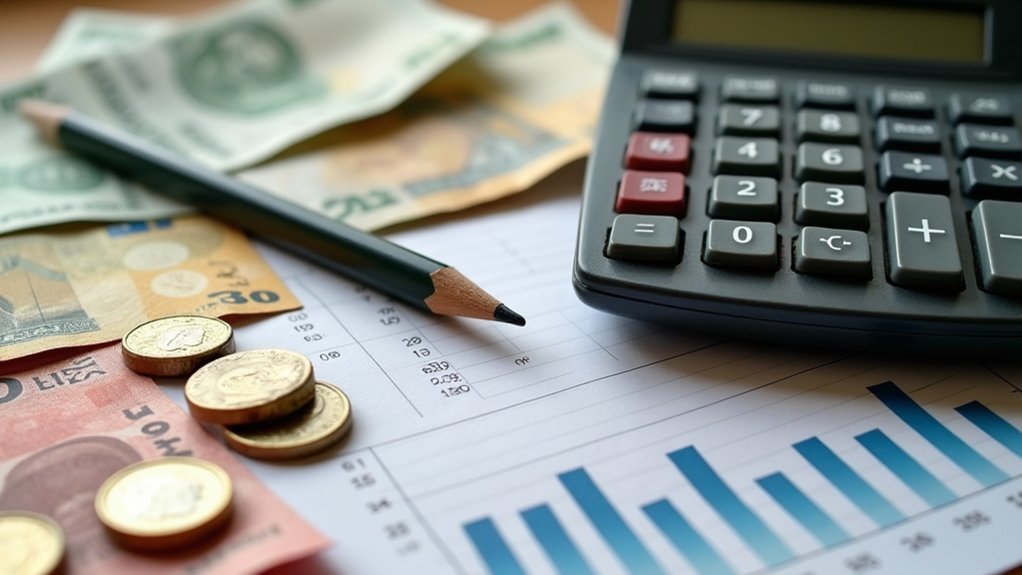Forex profit and loss boils down to one straightforward calculation: subtract the entry price from the exit price, then multiply by position size. Long positions profit when exit beats entry. Short positions flip that—entry minus exit determines the gain. Pip value matters too, with standard lots typically worth $10 per pip on EUR/USD. Position size amplifies everything proportionally, which means bigger trades equal bigger wins or bigger disasters. Japanese yen pairs measure pips differently at 0.01 instead of 0.0001. The mechanics get trickier with cross-currency pairs requiring additional conversions.

Calculating profit and loss in Forex sounds simple until an African trader actually tries to do it with their own money on the line. The basic formula looks clean on paper: profit or loss equals the difference between closing price and opening price, multiplied by position size and pip value. Reality hits differently when a trader in Lagos or Nairobi watches their account balance jump around.
Long positions use exit price minus entry price, then multiply by position size. Short positions flip it: entry price minus exit price, multiplied by position size. The math stays consistent, but the emotional weight changes fast when real money moves.
Buy formulas calculate as current rate minus open rate, multiplied by units and USD exchange rate. Sell formulas reverse that: open rate minus current rate, multiplied by units and USD exchange rate.
Pip movement drives everything. One pip represents a 0.0001 change in exchange rate for most pairs like EUR/USD. Japanese yen pairs measure pips as 0.01 instead, which confuses traders until they've blown through a few calculations. The pip movement formula equals pip movement multiplied by lot size and pip value. A standard lot EUR/USD trade with 10 pips movement at $10 per pip generates $100 profit. Not exactly retirement money. Traders use pips to measure price changes across different currency pairs in foreign exchange markets. Understanding the smallest price movement in forex helps traders accurately track how much their positions gain or lose with each market fluctuation.
Position size matters more than traders realize. Standard lots contain 100,000 units of base currency. Mini lots hold 10,000 units. Micro lots carry 1,000 units. Larger position sizes magnify both profits and losses proportionally, which sounds obvious until someone in Accra or Johannesburg discovers it the hard way. Calculating appropriate trade sizes based on account balance and risk tolerance helps protect capital from catastrophic losses. Advanced online platforms now automate most of these calculations, removing much of the manual complexity from the process.
Pip value depends on currency pair, lot size, and quote currency. Standard lot EUR/USD typically shows $10 pip value. Each pip worth $10 on a standard lot generates $500 profit from 50 pips movement. That calculation assumes everything goes right, which it often doesn't. The account denomination influences how pip values translate into actual monetary gains or losses for the trader. Continuous P&L analysis helps traders refine their strategies and identify areas for improvement over time.
Cross-currency calculations add layers of complexity. Trading cross pairs requires converting profit and loss into the account's base currency. An EUR/GBP profit traded from a USD account needs multiplication by the EUR/USD exchange rate. More conversions mean more room for calculation errors.
The P/L ratio calculates average profit on winning trades divided by average loss on losing trades. A winning average of $75 per trade and average loss of $25 produces a 3:1 ratio. Realized P/L represents profit or loss in closed positions. Unrealized P/L shows what's happening in current open trades. The difference between those two numbers tells the real story. Manual verification reduces overreliance on automated calculators and builds practical understanding of trade mechanics.
Common Questions
How Do Currency Restrictions in Countries Like Nigeria Affect Forex Profit Withdrawals?
Nigeria's currency restrictions slam forex traders hard. Banks slashed international spending—Stanbic IBTC down to $500 monthly, Zenith Bank to $200. Overseas ATM withdrawals? Capped at $100 or suspended entirely.
Foreign reserves dropped 19% year-on-year to $37.37 billion by June 2025, triggering dollar shortages. Traders can't easily pull profits out.
Limits apply per card, per month, regardless of account size. Multiple cards become necessary, adding compliance headaches.
The Central Bank tightened BDC operations too, killing alternative withdrawal routes. It's a bottleneck.
Which African Brokers Charge the Lowest Swap Fees for Holding Overnight Positions?
Exness and XM lead the pack for African traders chasing zero swap fees. Both offer proper Islamic accounts—Exness caps leverage at 1:2000, XM at around 1:500, minimum deposits a measly $10 and $5 respectively.
RoboForex and MultiBank Group also keep overnight charges low, swapping interest for flat daily commissions. FSCA regulates most of them, so it's not wild-west territory. Spreads might widen slightly to compensate, but for position traders, it beats bleeding money nightly.
Do I Pay Tax on Forex Profits in Kenya, South Africa, or Ghana?
Yes, forex profits are taxable in all three countries. Kenya taxes them as income at 10–35% progressive rates.
South Africa hits traders at 18–45% depending on brackets, plus possible capital gains tax.
Ghana charges up to 30% under its Income Tax Act.
All three require annual declarations.
Losses can be carried forward in Kenya for five years, offset in South Africa per SARS rules.
Non-compliance? Penalties and interest await. Keep records, file returns, or face the taxman's wrath.
How Does the Naira, Cedi, or Rand Volatility Impact My Profit Calculations?
Currency swings directly mess with pip values and margin requirements.
When the naira dropped over 40% in 2024, traders saw their dollar-based positions suddenly require different calculations at 1,600 naira per dollar versus previous rates.
Ghana's cedi jumped nearly 50% in 2025, forcing complete recalculation of profit targets for local currency accounts.
The rand's smaller 0.7% shift still altered pip values between 17.8 and 18.1 per dollar.
Volatile rates mean constantly adjusting position sizes and stop-losses.
Can I Calculate Profits Accurately When My Broker Quotes in USD Not Local Currency?
Yes, but it requires an extra step most African traders forget.
The broker shows USD profit, sure. But that's not what hits a Kenyan, Nigerian, or South African bank account. Multiply the USD amount by the live exchange rate at close—USD/KES, USD/NGN, USD/ZAR, whatever.
Exchange rates shift constantly, so timing matters. Miss that conversion or use stale rates? The local-currency profit figure becomes fiction.
Manual math invites errors; automated tools help but aren't foolproof.










